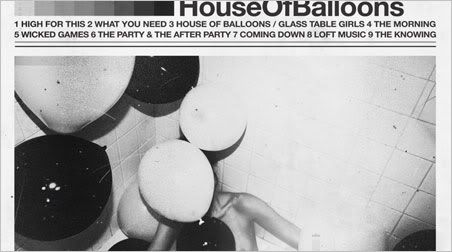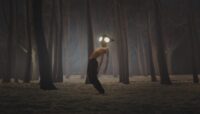
“What You Need”
from the mixtape House of Balloons
2011
The Weeknd. Is that just some hip omission of the “e” in “end”? Is it a statement on the minimalism that defines the group’s sleek R&B sound? “We don’t need that ‘e,’ just as much as we don’t need you to know our real names to love us. You’re going to understand us either way,” The Weeknd seems to say. After all, The Weeknd’s music has the smooth type of groove you find at the party still going at 5 AM, after the blacklight has burnt out and all that remains are empty glasses and a few lingering couples against the wall.
Or is the omission not an omission at all, instead an altered spelling of weakened? Is it a proclamation of The Weeknd’s state of affairs? Are these the musings of a broken down man coming to terms with his hedonistic nature? After all, vocalist Abel Tesfaye sings on “Wicked Games,” “Bring your love, baby, I can bring my shame / Bring the drugs, baby, I can bring my pain.”
Tesfaye postures as a man with power and pride – and quite well – but weaved throughout House of Balloons is a consistent self-awareness, a sense of weakness that humanizes him. It takes until the final track, “The Knowing,” where Tesfaye proclaims, “I know everything” in the song’s positively emphatic refrain, that he finally asserts himself as completely, undoubtedly strong. “These taunts don’t twist like they did before,” he sings.
Throughout House of Balloons, Tesfaye croons in a silky smooth R&B voice that gives The-Dream a run for his money, and frankly, blows Frank Ocean out of the water. Out of nowhere, he has established himself as the newest, freshest voice on the scene, albeit with promotion assistance from Drake. Both share the same hometown, Toronto, Canada, but it seems that all direct connections stop there. Early rumors speculated that Drake’s main producer, Noah “40” Shebib, also produced The Weeknd, but the group has shot down those rumors.
Instead, the producers of this collaborative are Illangelo and Martin “Doc” McKinney, relatively unknown producers (McKinney worked with Goodie Mob on a song for the film Slam in 1998) who seem to have taken their largest inspiration from last year’s breakout How to Dress Well. Like How to Dress Well, House of Balloons uses no sound that it does not need, even in the mixtape’s most uptempo, party-ready track, “House of Balloons/Glass Table Girls.” With little more than a basic beat, razor-sharp bass and synths, and backing vocals that could find their way into an Arcade Fire album given the right context, Illangelo and McKinney construct a track full of life and energy. Tesfaye arguably doesn’t have to do much to make the track an excellent one, but instead, he pushes it above and beyond with his soaring vocals.
In the track’s second half, the track deconstructs – rather brilliantly – into a straightforward beat and pulsating synth, like some warped R&B version of Nine Inch Nails’ “Closer.” Tesfaye, though still singing, moves into a more hip-hop styled verse that tends to ramble. It is in sections like these where Tesfaye seems the most uncomfortable, relying entirely on his limited lyrical swagger instead of his heightened ability to croon a memorable melody.
Luckily, though, these moments are few and far between. The bulk of the album relies on a slow, smooth R&B sound like “The Morning.” Its first verse is almost beatless, kept moving only by a faint, reverberated backbeat snare, making its build into the chorus all the more anthemic. Tesfaye uses this song as another opportunity to juxtapose his ambitious dreams with his real-life existence. “All that money, the money is the most,” the chorus repeats, but he admits in the second verse that he is “a virgin to that money, a virgin to the fame.”
Still, no song on the album best exemplifies The Weeknd like “What You Need.” Illangelo and McKinney compose their most minimal track here, with only a basic minor synth progression and an almost too-simple beat. A robotic exhale precedes the snares, almost mocking R&B’s traditional use of the female exhale as a bludgeon that exclaims, “Yes, I’m singing about sex!” Tesfaye’s vocals are filtered to make him more distant, but never are his melodies more powerful. “He’s what you want,” he repeats over and over, but he then emphatically states, “I’m what you need,” and he lets the delay do the rest of the work.
Despite being a free mixtape, House of Balloons feels like a true album, a true labor of love (and pain and hardship and everything else), more genuine than more prominent R&B stars, but perhaps that is due to The Weeknd’s anonymity. The music stands before the image – indeed, defines the image – contrary to so many other artists. The group has posted a YouTube video for every song, but each of them are static images, allowing the music to take center stage (“Coming Down” did have a full video, but YouTube removed the video due to apparent nudity). The Weeknd, now empowered with a fanbase, are now faced with a choice: define a physical image, or continue in shrouded anonymity?


